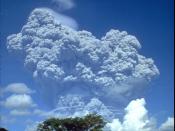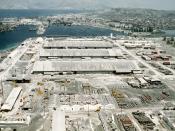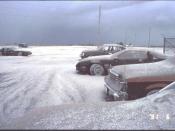Mount Pinatubo
In June 1991, the second largest volcanic eruption of the twentieth century took place on the island of Luzon in the Philippines, only 90 kilometres (55 miles) northwest of the capital city, Manila. Up to 800 people were killed and 100,000 became homeless following the eruptions, which climaxed with nine hours of eruption on the 15th June. On that day, millions of tons of sulphur dioxide were discharged into the atmosphere. This resulted in a decrease in the temperature worldwide over the next few years. Mount Pinatubo is part of a chain of volcanoes along the Luzon arc on the west coast of the island. The arc of volcanoes is due to the subduction of the Manila trench to the west. The volcano experienced major eruptions around 500, 3000, and 5500 years ago.
The events of the 1991 eruption began back in July 1990, when a magnitude 7.8
earthquake occurred 100 kilometres (62 miles) northeast of the Pinatubo region, later discovered to be a result of the reawakening of Mount Pinatubo. In mid-March 1991, villagers around Mount Pinatubo began feeling earthquakes and volcanologists began to study the mountain. (Around 30,000 people lived on the flanks of the volcano before to the disaster.) On April 2, small explosions from vents dusted local villages with ash. The first evacuations of 5,000 people were ordered later that month. Those earthquakes and explosions continued. Then on June 5, a high alert was maintained for two weeks due to the possibility of a major eruption. The explosion of a lava dome on June 7 led to the passing of a Level 5 alert on June 9, showing an eruption in progress. An evacuation area 20 kilometres (12.4 miles) away from the volcano was established and 25,000 people were evacuated and, on the following...


